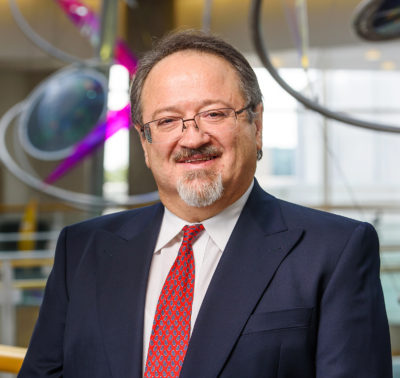
Stefan Sarafianos, PhD
Stefan Sarafianos is the rare researcher whose expertise spans structural biology, biochemistry, and virology. He recently led the groundbreaking development of a SARS-CoV-2 subgenomic replicon system, including mutants, that can be used for high-throughput screening and characterization of SARS-CoV-2 replicase inhibitors at a lower biosafety level—considerable benefits for pursuing studies such as drug discovery and inhibitors assay.
Many of us are familiar with the bedeviling question: “Do you want it faster, cheaper, and better? Pick one.” In the case of the replicon system Stefan Sarafianos has developed, researchers studying SARS-CoV-2 are able to benefit from all three and add one more—safer.
A native of Greece, Sarafianos did his undergraduate work in chemistry at the University of Patras and, after emigrating to the U.S., completed a PhD in biochemistry at Georgetown University in 1993.
Coronaviruses long have fascinated Sarafianos; however, as he entered academia in the early 1990s, he also felt a strong pull toward what he describes as “areas important to everyone at the time—HIV and drug resistance.”
Just a few years into that work, which began at Rutgers University and later included University of Missouri, he earned the Burroughs-Wellcome Young Scientist Scholarship Award at the International Workshop on HIV Drug Resistance in 1996. As a bookend to that early validation of his skill, in 2017 he was named a Fellow in the prestigious American Academy of Microbiology. That same year, Sarafianos was co-organizer of the International Retroviruses meeting at the famed Cold Spring Harbor Laboratory on Long Island, New York.
Sarafianos joined Emory in 2018 as the Nahmias-Schinazi Distinguished Research Chair and professor in the Emory University School of Medicine. He is associate director of a major division in the Department of Pediatrics called the Laboratory of Biochemical Pharmacology.
Since 2008, he has been awarded more than 50 grants or fellowships in the amount of nearly $35 million. He is also the author of 193 articles, 55 since coming to Emory. In 2020, Sarafianos and two Emory colleagues were among a group of Emory researchers honored with the COVID-19 Catalyst I3 Award, which brings with it a total of $250,000 made possible through a grant from the O. Wayne Rollins Foundation.
Getting his chance with SARS-CoV-2
Sarafianos thinks like a historian, noting relevant details of past outbreaks, and he certainly watched the rise of SARS in 2002–2003 and MERS in 2012 with interest and concern. He acknowledges that the scientific community “is just now getting good at detecting patterns that can determine future outbreaks.” Scarce funding opportunities had limited study of coronavirus in the past, but “once COVID-19 was here, I jumped into it,” he says.
SARS-CoV-2, as the largest of the RNA viruses, is a “tough one to work with and three times larger than HIV. It is complicated but that is also what makes it fascinating and fun to study,” says Sarafianos.
The benefits of his jumping in are considerable: Sarafianos and his research partners used replicon-based technologies to develop reagents and assays for advanced drug-discovery efforts against SARS-CoV-2 and for examining all facets of the SARS-CoV-2 replication cycle at a reduced biocontainment level.
Faster, cheaper, safer …
Institutions with biosafety-level 3 (BSL3) labs are few and far between, and the reason is plain: such labs are complex engineering structures expensive to build and operate; moreover, they require highly trained personnel and approval from the Centers for Disease Control and Prevention. These labs also bring with them a level of risk that litigation-averse entities, especially pharmaceutical companies, prefer to avoid. The fact that the replicon system allows scientists to conduct advanced SARS-CoV-2 research at the lower BSL2 is a transformative benefit that, according to Sarafianos, “democratizes SARS-CoV-2 research, opening up study of this virus to so many more labs worldwide.”
Also key is the replicon system’s ability to be used for high-throughput screening and characterization of SARS-CoV-2 replicase inhibitors. As Sarafianos points out, “For a big company, if they are going to use a replicon to screen for several million different conditions, every reduction in the number of steps is important, both time-wise and financially.”
The replicons use only part of the virus’s genome, making them noninfectious but still able to imitate parts of the viral replication that are of interest for drug discovery. Another aspect of safe development Sarafianos is pioneering involves using virus-like particles to create chimaeras that recapitulate the full replication cycle of the virus in BSL2 conditions. This technology will prove important in generating mutants that can point the way to better understanding drug resistance. “None of us wants an important therapy like Paxlovid, for instance, to someday prove ineffective, so facilitating research to study drug resistance can be game-changing,” says Sarafianos.
The replicon system, says Sarafianos, “is great for drug discovery, screening, and understanding how things work inside the cells. For vaccines, though, you need to include the spike, which sits on the outside of the virus. The chimaeras have the spike but only allow one replication cycle, which means that we can study compounds inside the cell and also probe how the virus negotiates entry into the cell—but without creating a fully infectious virus. This will be a breakthrough.”
… And (so much) better
Recent good news for efforts on this front was the receipt of a National Institutes of Health grant in the amount of $3,370,078 in support of the replicon research.
Sarafianos sums the work he has done this way: “The replicons are valuable tools that can be used at BSL2 for drug-discovery efforts, characterization of SARS-CoV-2 and variant evolution in the COVID-19 pandemic, mechanisms of inhibition and resistance, and studies on the role of SARS-CoV-2 genes and host-dependency factors.”
Not bad for a newcomer to this fight.